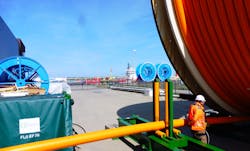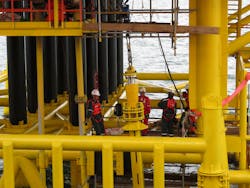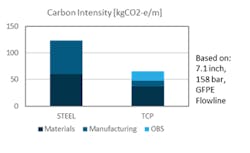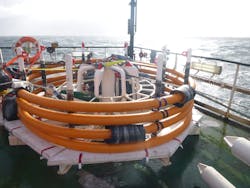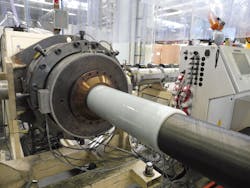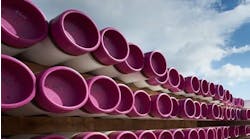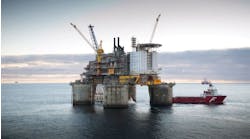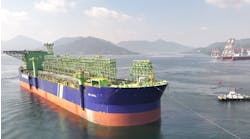Eliminates corrosion, lowers CO2 footprint
Martin van Onna, Airborne Oil & Gas
The global annual expenditure to mitigate corrosion is in the range of $2.5 trillion, roughly equal to 3.4% of the world’s GDP, according to NACE International. The corrosion problem is further magnified by enhanced oil recovery rates from mature fields. The use of water injection methods, for example, is leading hydrocarbons to become sourer, thereby over time, the production fluid that flows through the pipeline gradually becomes more corrosive. This is an increasingly complex challenge for operators as they are looking to raise production and profits while countering the potentially catastrophic consequences of corrosion with relatively ineffective and expensive inhibitors.
Until a decade ago, steel material for pipelines and pipe structures was the main option for the oil and gas industry. Now, the rapid development and deployment of thermoplastic composite pipe (TCP) is growing to counter the inherent drawbacks of steel: corrosion, fatigue, and weight.
There is now a growing variety of applications offshore which include flowlines, risers, jumpers, expansion spools, and lines for uses such as chemical injection, methanol injection, gas lift, wellbore access, choke and kill, decommissioning, and intervention.
Often, systems used to mitigate corrosion through pumping corrosion inhibitors need to have an uptime above 90% to be effective. Depending on the region, that is rarely achieved. For instance, in Asia operators are sometimes at only 50% uptime on their corrosion inhibitor system. To increase this uptime requires a constant supply of chemicals to the various platforms, working pumps and available power supply, all of which are working in a harsh offshore environment. Typically, for every month they lose on corrosion inhibitors, they lose a whole year of design life of the pipeline.
The composite pipe dream comes true
TCP features a solid pipe wall constructed from glass or carbon reinforcement fibers and thermoplastic polymeric materials. The proprietary melt-fusing manufacturing process results in a true composite structure, with the fibers fully embedded within the polymer matrix and ensuring the strongest interface possible between the different pipe layers. The fibers are linear in behavior and typically do not show plastic deformation or yielding. This creates a robust spoolable pipe, 80% lighter than metallic equivalents, and adapted to customer-specific requirements.
Based on the application, the company selects the right thermoplastic matrix and fiber to ensure it has the best fit-for-purpose solution for highly loaded, critical applications in the challenging offshore and subsea environments.
TCP can be installed with smaller vessels than traditional steel-based pipes. Where required, a weight coating can be applied, again based on the same polymer with additional heavy compounds.
Airborne Oil & Gas is fully qualified to DNV GL standards and was instrumental in the creation of the first standard for the requirements for flexible TCP for offshore applications, DNVGL-ST-F119. The document supports operators in their choice of TCP instead of steel or traditional flexibles for pipelines or risers.
The corrosive conundrum
Over the past 10 years there has been a relatively slow uptake in this new material. Residual reticence to adapt and change coupled with general ignorance on the benefits TCP can bring is now dissipating. In today’s cost-conscious climate, eliminating the corrosion problem and the issues it brings, while drastically slashing the cost for subsea infrastructure, are the two primary reasons for operators now assertively switching from steel to composite.
The value proposition that TCP has is two-fold. One is completely doing away with corrosion and the other is the reduction in total installation costs. This cost element is all around the ability to use small vessels to transport and install pipes in a cost-effective manner. This is not possible with steel pipes because the pipelay barge often must mobilize from other regions before pipeline installation can start.
As TCP Flowline is supplied in long, spoolable lengths, it is particularly cost-effective for horizontal lay methods, using rental reel drive and overboarding systems that can be placed on smaller vessels, resulting in around 40% saving on as-installed cost. In addition, the lack of corrosion reduces associated corrosion-related costs such as pumping of corrosion inhibitors, related pigging, and inspection and maintenance requirements.
In 2012, Petronas Carigali was the first operator to contract the company to supply a non-metallic, TCP subsea flowline pipe to eliminate all corrosion issues on its infield pipelines in Malaysia.
At the time, the operator had a large stock of corroding subsea flowlines suffering from sulphur reducing bacteria, or microbacteria induced corrosion. This led to an extensive five-year qualification program which included lab and prototype testing as well as full-scale offshore installation trials. In 2017, Petronas installed the world’s first pilot TCP Flowline in Malaysia for hydrocarbon service. A year later it was awarded Technology Readiness Level (TRL) 6 following comprehensive monitoring of the flowline.
TCP solutions, manufactured up to 7.5-in. ID, 121°C (250°F) and 10,000 psi (689 bar) working pressure, for hydrocarbon production, water, gas lift, and chemicals injection have since been installed in West Africa, the North Sea. Later this year more will be installed in Australia and West Africa.
A third added value is TCP operations offer a lower CO₂ footprint. From a manufacturing point of view, studies have shown that TCP has a much smaller carbon footprint compared to steel pipelines, and its installation provides even bigger savings on CO₂.
Life extension and production optimization
The company uses a specific ‘staircase approach’ for each of its clients, whereby operators can execute collaborative studies and pilots to optimize the disruptive potential and performance of TCP in their operations as well as build acceptance within the organization. Brownfield applications such as water injection and gas lift are ideal first applications for TCP, where the business case is strong and return on investment high.
Some of the latest contract awards include:
• Anasuria Operating Company ordered a gas lift jumper to support operations in the Guillemot field, about 175 km (109 mi) east of Aberdeen
• A supermajor ordered a 10-km (6-mi) flowline for water injection in West Africa
• A large operator in Asia ordered two off methanol injection jumpers.
The company allows the operator to use small vessels that are already in-country. Especially in West Africa, this makes a huge, very powerful case. Small vessels that are already in Angola, or in Ghana or in Nigeria, can be used to install these pipes. So, the mobilization cost is almost avoided.
For mature sectors such as the North Sea, TCP is proving its credibility to help enhance production particularly in brownfields for the replacement of old pipelines and/or the installation of gas lift.
At some point production hits a low level of a couple of thousand barrels. Many of the bigger companies will abandon this field and stop production. However, the firms that specialize in lengthening the field life through the company’s gas lift products, for example, are able to add an extra 10, 20 years or more of continuous production.
Pipeline innovation
In line with DNVGL-ST-F119, the Ijmuiden-headquartered business has carried out several qualification programs to certify its design methodology, production, and materials for all its products. Compared to steel pipe, TCP is competitive on up to 10 to 20 km (6.2 to 12 mi) of pipe. For corrosion resistant alloy, TCP is competitive altogether.
The company is continuing to develop, qualify, and deploy new and more advanced TCP products. This includes:
• Carbon fiber with polyamide 12 (PA12), qualified to 10,000 psi (689 bar) and 80°C (180°F) in use for water injection in the Gulf of Mexico
• Carbon fiber with polyvinylidene difluoride (PVDF) is now being qualified for up to 10,000 psi and 121°C (250°F). The combination of fiber and polymer offers the best alliance of submerged weight, chemical resistance, and minimum bend radius and will enable the commercial deployment of TCP dynamic risers
• Weight coating to give pipes greater stability on the seabed, without having to work with ballast elements or concrete, ropes or chains
• Development of ‘smart pipe’, such as the integration of optical fibers and sensing
• Enhanced insulation for higher temperature applications.
Conclusion
Carbon steel structures exposed to natural waters and corrosive environments generally corrode at an unacceptably high rate unless preventive actions are taken. An estimated one-sixth of all steel production worldwide is used to replace corroded metal, much of it at cooling water piping systems, and yet the rate of corrosion in pipelines is increasing and becoming more difficult to overcome.
Aker Solutions, Shell, Chevron, Evonik, Saudi Aramco, Subsea 7, and Sumitomo Corp. have all demonstrated belief in the future of disruptive composites for oil and gas applications with major investments in the company.
The corrosion challenge is a major issue in the industry. Next to fire, pipeline corrosion represents the most serious threat and monetary loss to any operation. •
